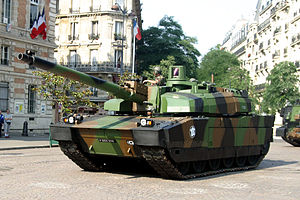Madiodha tank
| 2016-1 Model MBT | |
|---|---|
 Colloquially 'Madiodha' (Eng. Timberwolf) | |
| Type | Main battle tank |
| Place of origin | Fhainnaeran |
| Service history | |
| In service | 1993–present - Fhainnaeran (1,450, total, 400 of which are 2016-3 variant), Nahe (14 2016-1, two 2016-3), Covine PanNorth Popular Party(4), Another nation here (80) |
| Wars | Covine Ember War, Malokan Month's War |
| Production history | |
| Designed | 2014-2016 |
| Unit cost | 7.89 million Thaler/unit |
| Produced | 2016-present |
| No. built | 1,144 (2016-1), 402 (2016-3) |
| Variants | 2016-1 (Madiodha/Eng. 'Timberwolf'), 2016-2 (not built), 2016-3 (Consalacht/Eng. 'Consular') |
| Specifications | |
| Mass | 56.2 tons |
| Length | 30.4 ft (22.6 without gun) |
| Width | 12.1 ft |
| Height | 8.26 ft |
| Crew | 3 (Commander, gunner, driver) |
| Armor | Layered titanium and ceramic; additional semireactive armor on front and bottom hull and parts of turret (2016-3 variant) |
Main armament | 1982-1 Model 4.75" Rifled Cannon (38 rounds, one chambered, 30 HVAP rounds in auto-loader, 7 HE rounds in hull storage) |
Secondary armament |
|
| Engine | 1600 HP |
| Power/weight | 28.4 hp/t |
| Suspension | hydropneumatic |
| Fuel capacity | 1250 litres (1500 with fuel drums) |
| Maximum speed | 72mph on road, 58mph open offroad |
The 2016-1 MBT, colloquially known as the 'Madiodha' (Eng. Timberwolf), is a medium battle tank constructed by and primarily fielded by Fhainnaeran. It is unusual in that its construction incorporates expensive titanium armor instead of steel, and its cannon is a custom 4.75" barrel. It also serves in the armies of Nahe and ______.
Design
The vehicle features a similar configuration andthe same main gun, as its predecessor, the 1994-2 'Gray Wolf/Mact-liat' Model MBT. It features an updated machine gun, coaxial grenade launcher, and new counterfire active defense systems and ceramic and reactive armor elements along with an updated engine and minor improvements. Designers opted to forego a fourth crew spot in the 2016-1, instead layering internal sheeting to minimise shrapnel spread within the vehicle and adding a proper evacuation port on the bottom of the hull, along with quality-of-life improvements regarding ergonomics, such as the inclusion of an updated air conditioning system and remapping the seating arrangement to allow for greater mobility within the hull. In addition, the turret was slightly widened from the comparatively cramped and narrow 1994-2's, resolving serious issues with the gunner's mobility and the speed of disembarkment which had been noted in wargames. The use of titanium composite armor was contentious, as it dramatically affected the pricing per unit, but the advantage of greater mobility over steel and the considerable additional protection against light anti-tank weaponry and second-rate munitions eventually convinced military planners to accept the change, dependent on the inclusion of an additional layer of reactive armor along key areas of the vehicle. The coaxial grenade launcher was included primarily as a cost-effective system for launghing smoke and decoy flare rounds, but does have a limited anti-infantry capability to make up for the single machine gun.
The cannon, at a 4.75" caliber, is slightly larger than the typical 120mm cannon found in standard battle tanks, with the weapon primarily being designed to fire finless tungsten-core AP rounds, with an underpowered HE variant available in addition. As the design is focused on achieving any type of vehicle kill rather than requiring a total vehicle kill, the cannon design is focused around non- and low-explosive penetration; as a result, it is effective against most light vehicles and tanks in its weight class but requires the use of successive rounds or specialized HE ammunition to handle high-quality reactive armor.
Suppliers
The parts for the 2016-1 are manufactured entirely within Fhainnaeran, with the major companies involved being:
Use
The Timberwolf makes for an unusually comfortable ride for its crew, though its slightly low ammunition capacity has made it a target of accusations of pandering to low-ranking troops and deliberate suboptimal design. An unbuilt variant, the 2016-2, adds an additional twelve rounds of ammunition at the cost of compartment space, but was rejected due to the additional space being a key part of the ability of the crew to disembark on par with foreign tanks due to a smaller-than-average number of access ports. Upgrades to the design frequently feature the installment of foreign-built countermeasures systems and the replacement of the grenade launcher with a second machine gun in the coaxial slot.
Generally speaking, the tank is designed with easy winterization and rougher terrain in mind, making maintenance in regular conditions aside from the computer systems easy to manage next to many competing tanks. Maneuver training or numbers are important for operations against heavy armored units, but quiet deployments to conflicts abroad have proven the platform's effectiveness against most systems produced outside of the major powers. The 2016-1 is not a razor-edge tank in terms of its secondary armament and defense systems, but functions competently and handles well even with inexperienced crews, making it a solid platform for retrofits and a basis for future designs.
=Foreign Purchases/Licensing and Use+
Successors
There is currently no commission for a replacement for the Timberwolf, but the design of an elite 4-man variant, the 2016-3 'Consular' (Fhsn. Consalacht) is the subject of ongoing debate, as it features a license of an advanced Caphirian active defense system, which violates the traditional ban on foreign electronics in Fhainnin weapons systems. Speculation largely holds that the Fhainnin military is attempting to develop better active defenses for the next tank or 2016-variant, as the countermeasures of the 2016-1 work well overall but do not compare to Urcean or Caphirian equivalents.